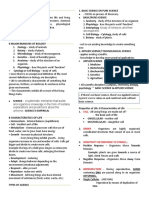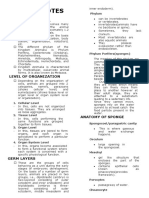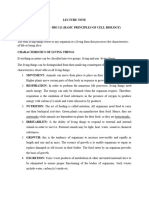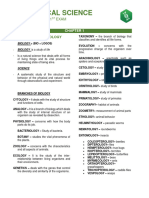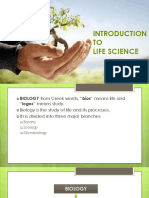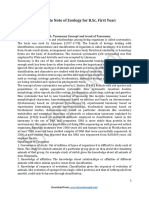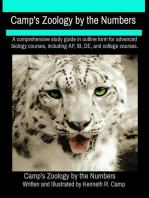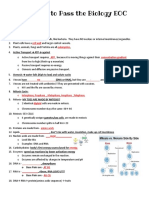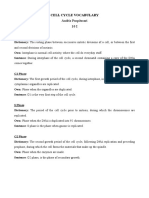0 ratings0% found this document useful (0 votes)
23 viewsCHAPTER-1 - Experimental Psychology
CHAPTER-1 - Experimental Psychology
Uploaded by
simonThis document provides an overview of zoology and cell biology. It defines zoology as the scientific study of animal life and discusses its history and subdivisions, including animal morphology, histology, anatomy, physiology, and more. It also explains the seven unifying characteristics of life and hierarchical organization of organisms. Additionally, it introduces the basic concepts of cells, including their structure, organelles, differences between prokaryotic and eukaryotic cells, and the cell cycle.
Copyright:
© All Rights Reserved
Available Formats
Download as DOCX, PDF, TXT or read online from Scribd
CHAPTER-1 - Experimental Psychology
CHAPTER-1 - Experimental Psychology
Uploaded by
simon0 ratings0% found this document useful (0 votes)
23 views4 pagesThis document provides an overview of zoology and cell biology. It defines zoology as the scientific study of animal life and discusses its history and subdivisions, including animal morphology, histology, anatomy, physiology, and more. It also explains the seven unifying characteristics of life and hierarchical organization of organisms. Additionally, it introduces the basic concepts of cells, including their structure, organelles, differences between prokaryotic and eukaryotic cells, and the cell cycle.
Original Description:
Original Title
CHAPTER-1- Experimental Psychology
Copyright
© © All Rights Reserved
Available Formats
DOCX, PDF, TXT or read online from Scribd
Share this document
Did you find this document useful?
Is this content inappropriate?
This document provides an overview of zoology and cell biology. It defines zoology as the scientific study of animal life and discusses its history and subdivisions, including animal morphology, histology, anatomy, physiology, and more. It also explains the seven unifying characteristics of life and hierarchical organization of organisms. Additionally, it introduces the basic concepts of cells, including their structure, organelles, differences between prokaryotic and eukaryotic cells, and the cell cycle.
Copyright:
© All Rights Reserved
Available Formats
Download as DOCX, PDF, TXT or read online from Scribd
Download as docx, pdf, or txt
0 ratings0% found this document useful (0 votes)
23 views4 pagesCHAPTER-1 - Experimental Psychology
CHAPTER-1 - Experimental Psychology
Uploaded by
simonThis document provides an overview of zoology and cell biology. It defines zoology as the scientific study of animal life and discusses its history and subdivisions, including animal morphology, histology, anatomy, physiology, and more. It also explains the seven unifying characteristics of life and hierarchical organization of organisms. Additionally, it introduces the basic concepts of cells, including their structure, organelles, differences between prokaryotic and eukaryotic cells, and the cell cycle.
Copyright:
© All Rights Reserved
Available Formats
Download as DOCX, PDF, TXT or read online from Scribd
Download as docx, pdf, or txt
You are on page 1of 4
CHAPTER 1: INTRO TO ZOOLOGY 2.
ANIMAL HISTOLOGY – study of microstructure
of tissues
- Is the scientific study of animal life
3. GROSS ANATOMY – the general visible
- It seeks to understand the sum total of all the
structures of animals as revealed by dissection
animals and animal population.
4. ANIMAL PHYSIOLOGY – the living process and
HISTORY OF ZOOLOGY functions of parts of the animal body
5. ZOOGEOGRAPHY – distribution of animals
- Is the sum total of all body activities of an according to space and region
organism. 6. ANIMAL EMBRYOLOGY – development and
- There are series of seven characteristics which growth of the new individual within the egg or
we call “unifying characteristics of life.” within the mother
SEVEN UNIFYING CHARACTERISTICS OF LIFE: 7. GENETICS – the laws of heredity and
variations
1. CELLULAR ORAGNIZATION – all organisms 8. ECOLOGY – the relationships of the animals to
consist of one or more cells. their environment
2. ORDERED CAPACITY – all living things are 9. TAXONOMY – study of the animal
complex and contains many complex classification
molecular structures. 10. PALEONTOLOGY – fossil animals and their
3. SENSITIVITY – all organisms respond to stimuli distribution in time
(e.g. movement) 11. ETHOLOGY – study of the animal behavior
4. GROWTH DEVELOPMENT AND 12. EVOLUTION – origin and differentiation of
REPRODUCTION – all organisms are capable of animal life
growing and reproducing
- They possess hereditary materials that are ZOOLOGY SPECIALIZATIONS
passed to their offspring ensuring that the A. PROTOZOOLOGY – study of protozoans
offspring is of the species. B. ICHTHYOLOGY – fishes
5. ENERGY UTILIZATION – all organisms take in C. ORNITHOLOGY – birds
energy and use it to perform many kinds of D. MALACOLOGY – mollusks
work E. ANTHROPOLOGY – study of man
6. HOMEOSTASIS – all organisms maintain a F. MAMMALOGY – mammals
relatively constant internal conditions G. PARASITOLOGY – parasites
- State of balance within all physical systems H. CONCHOLOGY – shells
needed for a body to function properly and I. HERPETOLOGY – reptiles and amphibians
survive (ex. body temp, blood sugar) J. ENTOMOLOGY – insects
7. EVOLUTIONARY ADAPTATION – all organisms
interact with other organisms of non-living THE SCIENTIFIC METHOD
environment in ways that influence their
1. OBSERVATION – begins with making careful
survival, and as a consequence, organisms
observations of the surroundings
evolve adaptations to their environment.
2. HYPOTHESIS – assumption made in order to
HIERARCHICAL ORGANIZATION draw out and test logical consequences and to
interpret practical situation or condition taken
A. CELLULAR LEVEL as the ground for action
- ATOMS, MOLECULES, MACROMOLECULES, 3. PREDICTION – the result expected from
ORGANELLES, CELL, TISSUE, ORGAN experimental test. A hypothesis serves as a
B. ORGANISMAL LEVEL prediction about the outcome of an
- ORGAN SYSTEM, ORGANSIM experiment
C. POPULATION LEVEL 4. METHOD OF EXPERIMENT – refers to the tests
- POPULATION, SPECIES, COMMUNITY, conducted in order to prove or disprove the
ECOSYSTEM, BIOSPHERE hypothesis and predictions
ZOOLOGY SUBDIVISION 5. RESULTS – outcomes of the experiment
6. CONCLUSION – result, outcome or a reasoned
1. ANIMAL MORPHOLOGY – study of animal judgement on th basis of evidence
form as a whole
7. THEORY – hypothesis supported through
many experiments done over a period of time.
CHAPTER 2: CELL: THE BASIC UNIT OF LIFE
- All living creatures are composed of cells, the
basic unit of life
- This cell performs various activities
- It grows, produces, and matures
PROKARYOTES VS. EUKARYOTES
EUKARYOTIC VS PROKARYOTIC CELLS
TAXONOMY – branch of biology that studies the
naming, arranging, classifying, and describing ULTRASTRUCTURE OF THE CELL
organisms into groups and levels.
A. CELL MEMBRANE – the outer covering of the cell
1. DOMAIN – highest level constitutes three domains - It functions as a selective barrier that
of life. regulates the entrance and exit of substances
2. KINGDOM – second most level constitutes five into the cell
kingdoms B. CYTOPLASM – the ground substance and the
3. PHYLUM – group of related classes biggest part of the cell where the organelles are
4. CLASS – group of related orders found
5. ORDER – group of related families
6. FAMILY – group of related genera CYTOPLASMIC ORGANELLES
7. GENUS – group of related species
1. THE ENDOPLASMIC RETICULUM - is a continuous
8. SPECIES – group of similar organisms
intercommunicating channel composed of
WHO IS THE FATHER OF TAXONOMY? – CAROLUS membrane-enclosed sacs and tubules
LINNAEUS - ER has a variety of functions among different
cell types (ex. it helps biosynthesis of steroid
hormones in endocrine cells)
TAXONOMY OF LIVING THINGS TWO FORMS OF ER
A. ROUGH ER – more common type of endoplasmic -The cell cycle is composed of four stages
reticulum
1. Gap 1 (G1)
- Presence of ribosomes
- Ribosomes – sites of protein synthesis 2. Synthesis (S)
B. SMOOTH ER – more tubular and non-granular due
to the absence of ribosomes 3. Gap 2 (2)
2. GOLGI APPARATUS – composed of sets of 4. Mitosis (M)
cisternae and numerous vesicles
- Responsible for sorting and packaging INTERPHASE – the cell is not undergoing division
macromolecules for use within the cell or for -Cell appears to be at rest
exocytosis (cell secretion)
3. THE MITOCHONDRION – the powerhouse of the -Cell performs its regular functions, taking in nutrients
cell and growing, preparing itself for division
- Varies in size, shape, and number, depending
STAGES OF INTERPHASE
on the degree of cellular activity
- It is the site of Adenosine Triphosphate (ATP) 1. THE G1 or Gap 1 Phase – the first phase of
synthesis and fatty acid oxidation interphase that comes before the synthesis of
4. LYSOSOME – small membrane-bound bodies that DNA
contain several hydrolytic enzymes, such as acid
-the cell increases in mass and size in preparation for
hydrolase, for intracellular digestion
cell division
- The word lysosome is derived from (lyso=lytic
or digestive; and soma=body) thus helping in 2. The S or Synthesis Phase – a crucial part of the
digestion interphase since this is when DNA is synthesized
5. CENTRIOLE – it is usually adjacent to the nucleus The G2 or Gap 2 Phase – comes after DNA
- Has a center role in cell division where it synthesis has occurred but prior to the start of
participates in the formation of the mitotic mitosis
spindle -the cell synthesizes proteins and continues to
C. NUCLEUS – found in almost cells increase in size
- It functions as a site where hereditary factors -chromosomes start to condense; proteins
are stored necessary for the construction of mitotic spindle
- It is a source of ribosomal (rRNA), messenger are synthesized
(mRNA), and transfer RNA (tRNA)
MITOSIS – A type of cell division that takes place in
1. NUCLEAR ENVELOPE (NE) – nucleus’ two-layered
somatic or body cells
outer limited separating it from the cytoplasm
- Nuclear pores (NP) can be seen in NE -main purpose of this division is the production of
- NP acts as a selective channels between the more cells for growth, repair, and development
cytoplasm and the inside of the nucleus
2. NUCLEOPLASM – also called as “karyoplasm” -produces two diploid (2n) somatic cells
- It is the fluid contained in the nucleus
- Suspended to it is the spherical, non-
membrane-bound nucleolus
3. CHROMATIN – found inside the nucleus
- It is made up of DNA and proteins and forms
chromosomes during cell division
- Two general types: euchromatin and
heterochromatin STAGES OF MITOSIS
CELL DIVISION 1. PROPHASE – chromatin condenses into more
discrete chromosomes
THE CELL CYCLE – Like any other living organisms, cells -nuclear envelope starts to disintegrate, and
also have their life cycle spindles form at opposite “poles” of the cell
-Eukaryotic cells: Cell cycle is a regular pattern of 2. METAPHASE – the spindle fibers fully developed-
growth, DNA replication, and cell division the chromosomes align at the equilateral plate
3. ANAPHASE – the paired chromosomes separate
and begin to move towards the opposite poles of
the cell
-at the end of anaphase, each pole contains a
complete set of chromosomes
4. TELOPHASE – the chromosomes are confirmed
into distinct new nuclei of the daughter cells
-Cytokinesis – the cytoplasm splits in two and the
cell divides
MEIOSIS – cell division that takes place in sex cells or
gametes
-Meiosis 1 and Meiosis 2
-Produces four genetically diverse haploid daughter
cells from one diploid parent cell
You might also like
- BIOLOGY Lesson Note SS 2Document6 pagesBIOLOGY Lesson Note SS 2jonahorji100% (1)
- Reading Comprehension: ContohDocument7 pagesReading Comprehension: ContohGesti Kinasih HardhiniNo ratings yet
- General Biology 1 (1st Quarter) ReviewerDocument6 pagesGeneral Biology 1 (1st Quarter) ReviewerAthena Marielle Lorenzo100% (4)
- Zoology Lesson 1 4Document9 pagesZoology Lesson 1 4Teodoro, Alexandra M.No ratings yet
- Grade 11 Biology ReviewerDocument5 pagesGrade 11 Biology ReviewerVen ReyNo ratings yet
- E Life Finals 1 3Document12 pagesE Life Finals 1 3kiannerdavidNo ratings yet
- BIO 1 - Introduction To Biological ScienceDocument10 pagesBIO 1 - Introduction To Biological Sciencechris santianaNo ratings yet
- Biochem Chapter 1 and 2 ReviewerDocument14 pagesBiochem Chapter 1 and 2 ReviewerPriscilla Niña DistrajoNo ratings yet
- MODULE 1 - BioDocument4 pagesMODULE 1 - BioSophie BaromanNo ratings yet
- What Is Science?: BiologyDocument9 pagesWhat Is Science?: Biologylordwill zaficoNo ratings yet
- Lesson 1 and 2 Zoology LecDocument11 pagesLesson 1 and 2 Zoology Lecadajarangel11No ratings yet
- Bio P1Document107 pagesBio P1fcvmwm2bzpNo ratings yet
- EASL Reviewer 1Document6 pagesEASL Reviewer 1adaojenny06No ratings yet
- Joseph Michael Cabaya General Biology Lesson 5: Evolution and Origin of Biodiversity: Patterns of Descent With ModificationDocument5 pagesJoseph Michael Cabaya General Biology Lesson 5: Evolution and Origin of Biodiversity: Patterns of Descent With ModificationJulimar CabayaNo ratings yet
- Zool Lec Midterm ReviewerDocument15 pagesZool Lec Midterm Reviewerishigamisenku574No ratings yet
- Igcse Biology Revision Booklet - 1Document50 pagesIgcse Biology Revision Booklet - 1Raahil MohamedNo ratings yet
- Tudy of Embryos and Their DevelopmentDocument12 pagesTudy of Embryos and Their DevelopmentJohn Harold AstronomoNo ratings yet
- Biology Full NotesDocument259 pagesBiology Full NotesthaseiphologoNo ratings yet
- The Living WorldDocument11 pagesThe Living Worldananthiaselvi974No ratings yet
- LOPEZC - Biology NotesDocument11 pagesLOPEZC - Biology Notescasey lNo ratings yet
- GenBio1 Midterm Notes 1Document30 pagesGenBio1 Midterm Notes 1Just JasperNo ratings yet
- Intro+Chapter+1+(Honors)Document44 pagesIntro+Chapter+1+(Honors)jamesdiscord523No ratings yet
- General Biology 1Document4 pagesGeneral Biology 1Tapnio Glezel GolongNo ratings yet
- Mar 2018 Biology NotesDocument9 pagesMar 2018 Biology NotesEllah Gutierrez100% (2)
- BiologyDocument39 pagesBiologyRizzuya UrakuwaNo ratings yet
- BIO101 General Biology IDocument14 pagesBIO101 General Biology Imabelgodfrey467No ratings yet
- Notes On Ss1 First Term Biology LessonsDocument154 pagesNotes On Ss1 First Term Biology LessonsogbanukogodswillNo ratings yet
- General Biology 2 LAS Quarter 3 Week 7 8Document18 pagesGeneral Biology 2 LAS Quarter 3 Week 7 8Hekdeg Hakdog0% (1)
- General Biology Lesson 1 REVIEWERDocument7 pagesGeneral Biology Lesson 1 REVIEWERKrishian Erl AndogNo ratings yet
- Biology Pag Review Na Lay Kay Lagyo Kaayo Tag SeatsDocument4 pagesBiology Pag Review Na Lay Kay Lagyo Kaayo Tag SeatsmohammadnursieNo ratings yet
- General Zoology (Notes)Document6 pagesGeneral Zoology (Notes)Faith Hannah Oro100% (1)
- Earth and Life Science Reviewer For 2nd QuarterDocument15 pagesEarth and Life Science Reviewer For 2nd QuarterAliyah CeelinNo ratings yet
- WEEK2 ModuleLec (BIO101)Document9 pagesWEEK2 ModuleLec (BIO101)Maricris GatdulaNo ratings yet
- Reviewer in ZoologyDocument21 pagesReviewer in ZoologyHazel AnnNo ratings yet
- Reviewer in Biology 1Document6 pagesReviewer in Biology 1CameronNo ratings yet
- Questions Biology of The CellDocument17 pagesQuestions Biology of The CellIvana MajovskáNo ratings yet
- Cell BiologyDocument34 pagesCell BiologyBamideleNo ratings yet
- Genbio 1Document10 pagesGenbio 1Marxinne PajarinNo ratings yet
- Biology BookDocument51 pagesBiology BookRam NepaliNo ratings yet
- Biology Reviewer 2021Document8 pagesBiology Reviewer 2021Keano Gelmo100% (1)
- Dagatan 2nd ModuleDocument12 pagesDagatan 2nd ModuleAkagisan DagatanNo ratings yet
- Gen Bio DorayDocument3 pagesGen Bio DorayNate Dela VegaNo ratings yet
- Cells: Developmental Biology ReviewerDocument13 pagesCells: Developmental Biology ReviewerCarmela LipoNo ratings yet
- Lecture 1 ANAPHY NotesDocument6 pagesLecture 1 ANAPHY Notesmileyyykenzie34No ratings yet
- Bio Science Chap 1 3 Exam NotesDocument10 pagesBio Science Chap 1 3 Exam Notesalthea amparadoNo ratings yet
- Organ System: Kingdom AnimaliaDocument18 pagesOrgan System: Kingdom AnimaliaTanishq AroraNo ratings yet
- E&L Science 8-22-19Document2 pagesE&L Science 8-22-19Borbe ClauNo ratings yet
- Unit-1 NotesDocument58 pagesUnit-1 NotesVaishnavi BodireddyNo ratings yet
- Introduction To Life ScienceDocument2 pagesIntroduction To Life ScienceLiezelMagbooNo ratings yet
- Anatomy and Physiology PrelimsDocument16 pagesAnatomy and Physiology PrelimsChaline MarieNo ratings yet
- Biology ReviewerDocument8 pagesBiology Reviewerabaderica111No ratings yet
- Characteristic of Life: The Breaking Down of CompoundsDocument5 pagesCharacteristic of Life: The Breaking Down of CompoundsHanz GadongNo ratings yet
- Introduction To Life ScienceDocument43 pagesIntroduction To Life Sciencedivina villegasNo ratings yet
- SpongesDocument27 pagesSpongesNatashanuke Aelke MariskaNo ratings yet
- Biology Reviewer For MidtermsDocument20 pagesBiology Reviewer For MidtermsocampofranccineNo ratings yet
- Zoology 1 Year Part A 1Document68 pagesZoology 1 Year Part A 1Pankaj KewratNo ratings yet
- GenBio - 1st-Sem - LATEST MEGADocument16 pagesGenBio - 1st-Sem - LATEST MEGAanthoniorabadonNo ratings yet
- GenBio - 1st-Sem - LATEST GIGA UPDATEDDocument25 pagesGenBio - 1st-Sem - LATEST GIGA UPDATEDanthoniorabadonNo ratings yet
- Chapter 1 Themes in The Study of LifeDocument6 pagesChapter 1 Themes in The Study of LifeJamillah Ar GaNo ratings yet
- Camp's Zoology by the Numbers: A comprehensive study guide in outline form for advanced biology courses, including AP, IB, DE, and college courses.From EverandCamp's Zoology by the Numbers: A comprehensive study guide in outline form for advanced biology courses, including AP, IB, DE, and college courses.No ratings yet
- Unit-VI: Reproduction in Plants Chapter-1. Asexual and Sexual Reproduction in Plants Book Back AnswersDocument70 pagesUnit-VI: Reproduction in Plants Chapter-1. Asexual and Sexual Reproduction in Plants Book Back AnswersTwelegyNo ratings yet
- Bio 93 Midterm 2 Review Session KEYDocument121 pagesBio 93 Midterm 2 Review Session KEYKenosNo ratings yet
- Question Bank - Introduction To Computational Biology - Unit 1 - Cell and EvolutionDocument17 pagesQuestion Bank - Introduction To Computational Biology - Unit 1 - Cell and EvolutionMadhav SinhaNo ratings yet
- Mitosis in Root TipDocument16 pagesMitosis in Root TipANKIT KUMARNo ratings yet
- Table of Specs 4th Quarter in Grade 8 ScienceDocument2 pagesTable of Specs 4th Quarter in Grade 8 ScienceAileen VillagraciaNo ratings yet
- Practical Record Writing 24-25Document21 pagesPractical Record Writing 24-25b5fsv2fxqrNo ratings yet
- ChlamydomonasDocument7 pagesChlamydomonasansaanwar88No ratings yet
- IB Biology Notes - 42 MeiosisDocument7 pagesIB Biology Notes - 42 MeiosisJohn Philip D. NapalNo ratings yet
- Week 4 A&P 2 Lab Exercise 27.1-27.14Document30 pagesWeek 4 A&P 2 Lab Exercise 27.1-27.14Rhaisa TsyboukovNo ratings yet
- Bio f4 Chap 5 Cell DivisionDocument30 pagesBio f4 Chap 5 Cell Divisionplj_jane6508No ratings yet
- 5.1.2 Meiosis and VariationDocument9 pages5.1.2 Meiosis and VariationRyeaan AnwarNo ratings yet
- Important Questions For CBSE Class 11 Biology Chapter 10Document11 pagesImportant Questions For CBSE Class 11 Biology Chapter 10Purva YadgireNo ratings yet
- Lecture Recombination - Homologous Recombination (Final)Document27 pagesLecture Recombination - Homologous Recombination (Final)ijazNo ratings yet
- Sexual Reproduction PDFDocument4 pagesSexual Reproduction PDFPerry SinNo ratings yet
- 50 Facts To Pass The Biology EOCDocument3 pages50 Facts To Pass The Biology EOCThefryboioNo ratings yet
- Unit 2 Cells, Development, Biodiversity and ConservationDocument47 pagesUnit 2 Cells, Development, Biodiversity and ConservationEllane leeNo ratings yet
- 10th Science English MediumDocument41 pages10th Science English MediumgcrajasekaranNo ratings yet
- Comparing Meiosis and MitosisDocument6 pagesComparing Meiosis and MitosisGelo VeeNo ratings yet
- Assessment 2 Unit 2Document23 pagesAssessment 2 Unit 2maya 1DNo ratings yet
- 3.3 Meiosis Interactive Story - GuidanceDocument9 pages3.3 Meiosis Interactive Story - GuidancettNo ratings yet
- 9th Biology Urdu NotesDocument59 pages9th Biology Urdu NotesMuhammad Iqbal84% (44)
- GametogenesisDocument25 pagesGametogenesisJoanne Crishna MiguelNo ratings yet
- Cell Cycle VocabularyDocument3 pagesCell Cycle Vocabularyapi-328162824No ratings yet
- Table of Specs For Grade 8 Science Quarter 4 - SY 2022 2023 - FinalDocument1 pageTable of Specs For Grade 8 Science Quarter 4 - SY 2022 2023 - FinalJayron SuazeNo ratings yet
- Genetics Practice QuestionsDocument12 pagesGenetics Practice Questionskehasehaftom0No ratings yet
- Lab 3 Mitosis and Meiosis Pre LabDocument1 pageLab 3 Mitosis and Meiosis Pre LabS. Spencer0% (2)
- ANAT2341 Embryology 2009 Lectures PDFDocument232 pagesANAT2341 Embryology 2009 Lectures PDFTajamul islam100% (1)
- Meiosis and Genetic DiversityDocument25 pagesMeiosis and Genetic DiversityBasla MalikNo ratings yet
- Chap. 5 Molecular Genetic Techniques: TopicsDocument28 pagesChap. 5 Molecular Genetic Techniques: TopicsanushkaNo ratings yet
















